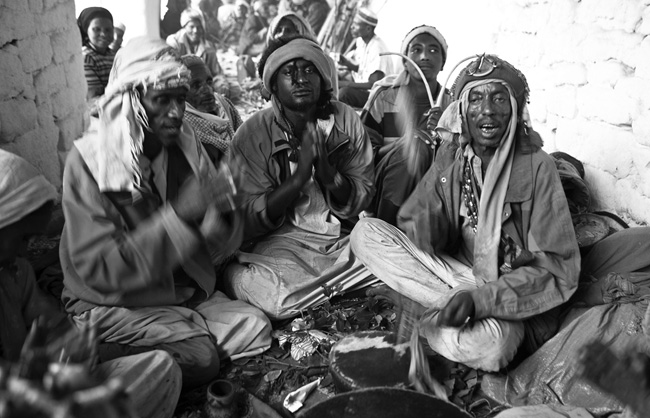Ethiopia
Oromos Pilgrims of Sheikh Hussein
Oromos Pilgrims of Sheikh Hussein
Where: Ethiopia
When: 2010
Every year, tens of thousands of people—mostly Oromo—gather from all over the Horn of Africa, and even further afield, for a little-known mystical pilgrimage to the Mausoleum of Sheikh Hussein.
Nestled in the remote Bale Mountains, some 600 kilometers from Addis Ababa, the village of Annajina is barely a dot on the map. Yet twice a year, it becomes a vibrant spiritual center, drawing pilgrims to one of the largest, most unorthodox, and culturally diverse Islamic gatherings in the region.
Many of these pilgrims, unable to afford the Hajj to Mecca, make their way instead to Sheikh Hussein’s tomb—a revered figure credited with spreading Islam across the Oromo territories of Ethiopia. A first pilgrimage takes place at the beginning of the year to celebrate the saint's birth. A second coincides with Eid al-Adha, the feast of sacrifice, transforming this quiet village into a three-day center of faith and devotion, at the crossroads of Islam and animist beliefs.
A Sufi mystic from the 14th century, Sheikh Hussein is said to have been the first Muslim missionary to penetrate deep into Ethiopia. Among the Oromo—Ethiopia’s largest ethnic group, making up a third of the population—he is venerated not just for his wisdom, but for the miracles attributed to him. The prayers and chants offered by the pilgrims echo pre-Islamic rituals, blending Islamic faith with ancestral beliefs. Many Oromo still invoke Waaq, the sky god of their ancestors, through the intercession of the saint—a striking example of religious syncretism.
Pilgrims arrive with bundles, firewood, and blankets, setting up makeshift camps with relatives and fellow villagers. Local residents, as tradition demands, welcome them and offer a patch of land to settle. Their first stop after installation is the mausoleum. A few steps before the entrance, worshippers remove their shoes. Inside, they lie face down in silence, press their lips or foreheads to the whitewashed walls, and prostrate in font of the tomb. They gather dust from the floor, rub it onto their faces, and sometimes swallow it. They stay there for hours, crying and praying Sheikh Hussein to grant them blessings for crops or healing.
Once outside the mausoleum, the praises to the saint continue, to the sound of music and dance. Qat—an energizing plant widely consumed across the Horn of Africa—is freely shared. Men and women sit in circles, chewing its tender leaves, before starting the great Eid prayer in front of the village school. Dressed in white, the men form the front rows, while women dressed in bright colors, follow behind. For a brief moment, the focus changes: they pray to Allah and the Prophet Muhammad, united with Muslims worldwide. But as they return to their tents and gather around grilled mutton, the chants to Sheikh Hussein rise again into the night.






















